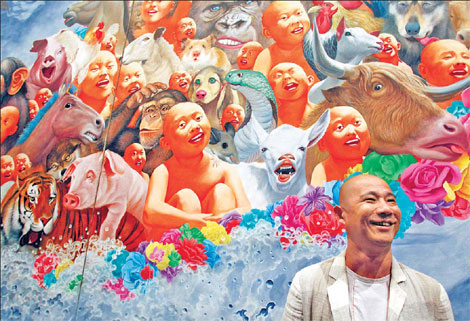A bald truth
Feisty avant-garde artist, Fang Lijun, insists his works merely mirror the situation on the ground and dismisses criticisms he is peddling an image of "ugly Chinese."
 |
|
Fang Lijun, one of the hottest contemporary Chinese artists, stages a comprehensive solo exhibition at Today Art Museum in Beijing. [China Daily] |
Fang Lijun is well aware of his reputation as one of the nation's most envied as well as hated avant-garde artists. The 47 year old drives deluxe sedans, breeds bulldogs, runs two restaurant chains and hotels, and has spacious studios in Beijing and in southwestern Yunnan province.
His works sell for millions of dollars at international auctions, and some are in the collections of prestigious museums such as the Pompidou Center in Paris and the Museum of Modern Art in New York.
But he is often accused of churning out repetitive works "to cater to Western collectors" and of presenting an ugly picture of the Chinese in his unorthodox paintings, installations, prints and sculptures.
"People have a number of negative views about me," Fang says. "That is understandable as most know me only through the news and scholarly essays which are often, if not always, misleading and confusing."
To correct this image Fang is, besides his newly published autobiography To Live Like a Wild Dog, staging an exhibition at Today Art Museum "to reveal the stories behind each of my well-known works".
On until Sept 8, the exhibition will display a range of his works - from brightly colored massive paintings, small-sized prints, installations, and sculptures, to photographs, manuscripts, documents, videos, early ink works and pencil sketches - chronicling his evolving artistic life.
One of Fang's best-known motifs is the stereotypical, disenfranchised bald youth - said to represent farmers.
But it has now come to symbolize a generation rendered as bored simpletons by the paralyzing extremism of a rapidly transforming Chinese society, according to Fang, "where individuals are virtually faceless and nameless."
A defining feature of his works is swirls of clouds, in an intense cobalt blue, permeating water, babies, flowers, and insects.
The artist often manipulates perspective by juxtaposing the sharp focus in the immediate foreground with clouds filling the far distance.
The beautiful serenity of the fragile, ethereal, and chromatically unreal flowers, for example, belie the loss of perspective.
This kind of painting is a metaphor for disorientation and a lack of direction, Fang explains in his new book.
Most of the prints, paintings and installations on show are deliberately unnamed, "to leave viewers more room to use their imagination and their personal memories," Fang says.
One huge diptych painting depicts a band of Fang's trademark baldheads, animals and insects in the story of Noah's Ark.
Another shows a baldheaded youth from behind, wearing a crown of disgusting insects.
One installation features sleeping babies in transparent, plastic balls; another presents a large drinking barrel run through with various tubes, in reference to the heart and its arteries.
Some recent works on display depart from the style of his earlier works. However, their themes seem to connect with his continued efforts to capture a world adrift, of a people lost in space and time.
"I want to show the public that my works do not come from nowhere. The changing social reality has exerted an impact on my worldview and my art," says the artist.
"I live by my heart. And my works reflect my personal history and my perception of the human condition today."
Like many youths of his generation, Fang lived through the tumultuous years of the "cultural revolution"(1966-76), the downfall of the Gang of Four, the early years of the opening- up and reform, and the recent surge of consumerism and materialism.
"Every individual is precious and has his or her value on this earth. Everyone's life is unique," Fang says.
In his view, art is more about one's inner growth than about theory and technique.
"That may explain why artists of my generation came from the same social background, received a similar education, learned the same skills but ended up using different approaches to art."
Fang insists the world is not as perfect or beautiful as it seems.
Reacting to criticisms that he indulges in creating a sense of disillusionment, boredom, cynicism, and absurdity, Fang says: "My art is closely associated with the current condition of Chinese society. It is an honest mirror of social malaise."
 0
0 







Go to Forum >>0 Comments